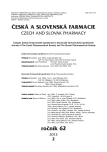-
Články
- Vzdělávání
- Časopisy
Top články
Nové číslo
- Témata
- Videa
- Podcasty
Nové podcasty
Reklama- Kariéra
Doporučené pozice
Reklama- Praxe
Evaluation of the influence of sterilization method on the stability of carboxymethyl cellulose wound dressing
Authors: Jan Muselík; Lenka Wojnarová; Ruta Masteiková; Tomáš Sopuch
Authors place of work: Veterinární a farmaceutická univerzita Brno, Farmaceutická fakulta, Ústav technologie léků 1; Lékárna Sfinx, Brno 2; Holzbecher spol. s r. o. barevna a bělidlo Zlíč, divize Holzbecher Medical 3
Published in the journal: Čes. slov. Farm., 2013; 62, 95-98
Category: Původní práce
Summary
Carboxymethyl cellulose, especially its sodium salt, is a versatile pharmaceutical excipient. From a therapeutic point of view, sodium salt of carboxymethyl cellulose is used in the production of modern wound dressings to allow moist wound healing. Wound dressings must be sterile and stable throughout their shelf life and have to be able to withstand different temperature conditions. At the present time, a number of sterilization methods are available. In the case of polymeric materials, the selected sterilization process must not induce any changes in the polymer structure, such as polymer chains cleavage, changes in cross-linking, etc. This paper evaluates the influence of different sterilization methods (γ–radiation, β–radiation, ethylene oxide) on the stability of carboxymethyl cellulose and the results of long-term and accelerated stability testing. Evaluation of samples was performed using size-exclusion chromatography. The obtained results showed that ethylene oxide sterilization was the least aggressive variant of the sterilization methods tested. When the γ-radiation sterilization was used, the changes in the size of the carboxymethyl cellulose molecule occurred. In the course of accelerated and long term stability studies, no further degradation changes were observed, and thus sterilized samples are suitable for long term storage.
Keywords:
carboxymethyl cellulose – sterilization – stability testing – size exclusion chromatography
Zdroje
1. Wiegand C., Abel M., Ruth P., Wilhelms T., Schulze D., Norgauer J., Hipler U.-C. Effect of the sterilization method on the performance of collagen Type I on chronic wound parameters in vitro. Biomed. Mater. Res. Part B 2009; 90B, 710–719.
2. Labarre D., Ponchel G., Vauthier C. Biomedical and Pharmaceutical Polymers. 1st ed. London: Pharmaceutical Press 2010.
3. Bushell J. A., Claybourn M., Williams H. E., Murphy D. M. An EPR and ENDOR study of γγ - and ββ-radiation sterilization in poly(lactide-co-glycolide) polymers and microspheres. J. Control. Release 2005; 110, 49–57.
4. Choi J. I., Lee H. S., Kim J. H., Lee K. W., Lee J. W. Seo S. J., Kang K. W., Byun M. W. Controlling the radiation degradation of carboxymethylcellulose solution. Polym. Degrad. Stabil. 2008; 93, 310–315.
5. Fei B., Wach R. A., Mitomo H., Yoshi, F., Kume T. Hydrogel of biodegradable cellulose derivatives. I. Radiation-induced crosslinking of CMC. J. Appl. Polym. Sci. 2000; 78, 278–283.
6. Liu P., Zhai M., Li J., Peng J., Wu J. Radiation preparation and swelling behavior of sodium carboxymethyl cellulose hydrogels. Rad. Phys. Chem. 2002; 63, 525–528.
7. Lee H. S., Choi J. I., Kim J. H., Lee K. W., Chung Y. J., Shin M. H., Byun M. W., Shin M. G., Lee J. W. Investigation on radiation degradation of carboxymethylcellulose by ionizing irradiation. Appl. Radiat. Isotopes 2009; 67, 1513–1515.
8. Choi J. I., Lee H. S., Kim J. H., Lee K. W., Chung Y. J., Byun M. W., Lee J. W. Effect of electron beam irradiation on the viscosity of carboxymethylcellulose solution. Nucl. Instrum. Meth. B 2008; 266, 5068–5071.
9. Vetchý D., Frýbortová K., Rabišková M., Häring A. Testování stability léčivých přípravků. Chem. Listy. 2006; 100, 24–29.
Štítky
Farmacie Farmakologie
Článek vyšel v časopiseČeská a slovenská farmacie
Nejčtenější tento týden
2013 Číslo 2- Ukažte mi, jak kašlete, a já vám řeknu, co vám je
- Pomůže AI k rychlejšímu vývoji antibiotik na kapavku a MRSA?
- Psilocybin a neurodegenerace: Kam míří současný výzkum?
-
Všechny články tohoto čísla
- Dr.h.c., prof. RNDr. Jozef Čižmárik, PhD. – sedemdesiatnik
- RNDr. PhMr. Štefan Mareček *20. 7. 1920 †28. 1. 2013
- Fytoterapia v súčasnej medicíne
-
Fyziologické aspekty lipoxygenázy v signálnych systémoch rastlín
Časť I. Oktadekánová cesta - Pokroky ve využití instrumentálního měření barevnosti ve vývoji, výrobě a v kontrole jakosti léčiv, léčivých přípravků a farmaceutických pomocných látek I
- Optimalizace disolučního profilu diklofenaku sodné soli z halloysitových nanotubulů
- Thiosemikarbazony a jejich antimykobakteriální účinky
- Estery aminopyrazinkarboxylové kyseliny jako potenciální antimykobakteriální léčiva
- Vliv stupně substituce na nasákavost kyselé formy karboxymethylcelulosy v podobě netkané textilie
- Hodnocení vlivu sterilizační metody na stabilitu karboxymethylcelulosového krytí na rány
- Prolegomenon of the Czech pharmacognosy: 21st century
- Česká a slovenská farmacie
- Archiv čísel
- Aktuální číslo
- Informace o časopisu
Nejčtenější v tomto čísle- Hodnocení vlivu sterilizační metody na stabilitu karboxymethylcelulosového krytí na rány
- Prolegomenon of the Czech pharmacognosy: 21st century
- Dr.h.c., prof. RNDr. Jozef Čižmárik, PhD. – sedemdesiatnik
- Fytoterapia v súčasnej medicíne
Kurzy
Zvyšte si kvalifikaci online z pohodlí domova
Současné možnosti léčby obezity
nový kurzAutoři: MUDr. Martin Hrubý
Autoři: prof. MUDr. Hana Rosolová, DrSc.
Všechny kurzyPřihlášení#ADS_BOTTOM_SCRIPTS#Zapomenuté hesloZadejte e-mailovou adresu, se kterou jste vytvářel(a) účet, budou Vám na ni zaslány informace k nastavení nového hesla.
- Vzdělávání



